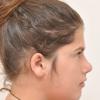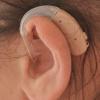It's about one of the most common syndromes, which can affect multiple organs and systems such as the cardiovascular (congenital heart defects) as well as the immune system (DiGeorge Syndrome). It may occur difficulties in feeding and rhinolalia with or without cleft palate. In its most mild types, it can remain undiagnosed while in more serious cases it may endanger the child's life.
MORPHOLOGICAL CHARACTERISTICS
The patients with velocardiofacial syndrome have a characteristic facial appearance.
- He/she may appear hypotonia (low muscle tone), with narrow eyelid lacerations and "swelling" of the eyelids.
- Elongated face, almond-shaped eyes, wide nose, small ears.
- The mouth size may seem somewhat smaller than usual, with the corners of the lips facing down.
- Nasal-sounding speech and nasal regurgitation.
- Common finding is the existence of cleft palate or submucous cleft palate.
- The nasal speech is not necessary to be accompanied by cleft palate but to be caused by an "hypodynamic palatal-pharyngeal" function.
- The flaps of the ears may have a peculiar conformation with abnormally folded helices.
Approximately 15% to 20% of people with this syndrome suffer from the Pierre Robin Sequence.
DIAGNOSIS
If there are heart problems, diagnosis is done in infancy by the pediatricians and pedocardiologists. But if there are no heart problems, then the diagnosis is usually done in an older age from the group of doctors that are occupied with clefts. This group will follow-up the child because of cleft palate which may he/she has or due to nasal speech. It must also be stressed that there may be a high index of suspicion for the diagnosis.
The diagnosis is confirmed by genetic analysis. In the 90% of the cases, it's about a new mutation, while the 10% is inherited from the parents.
PROBLEMS THAT ACCOMPANY THE VELOCARDIOFACIAL SYNDROME (VCFS)
Apart from the problems that we mentioned above, people with this syndrome may experience learning disabilities as well as neurological and psychiatric problems in high frequency. From the people with velocardiofacial syndrome, about 10% suffer from DiGeorge syndrome which is essentially a congenital immunodeficiency with multiple endocrine, immunological and cardiac (heart) abnormalities.
WHEN AND HOW REHABILITATION IS PERFORMED
If there are heart problems, they will be corrected during infancy, usually with surgery. If the problem that occurs and leads to diagnosis is the cleft palate then the surgical repair of the cleft is performed as in all cases of clefts. The problem of rhinolalia in patients with a velocardiofacial syndrome is quite complex as it may be due to palatal and pharyngeal muscular hypotonia. In such cases, the surgical repair of the palate and speech therapy may not help significantly. In the cases with nasal speech without the existence of cleft palate or submucous cleft palate, someone may recur to a pharyngoplasty, but always with restrained optimism regarding to the functional results.
If there are no severe heart problems, life expectancy is normal. The children with this syndrome require special attention and must be performed a thorough check-up (or follow-up) so as not to escape evidences which need to be assessed carefully as for example developmental delays or immunological and endocrine problems.




